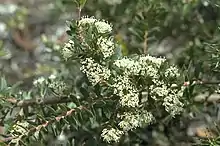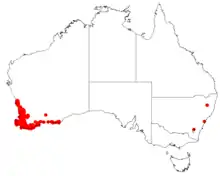| Candle hakea | |
|---|---|
 | |
| Hakea ruscifolia in the ANBG | |
| Scientific classification | |
| Kingdom: | Plantae |
| Clade: | Tracheophytes |
| Clade: | Angiosperms |
| Clade: | Eudicots |
| Order: | Proteales |
| Family: | Proteaceae |
| Genus: | Hakea |
| Species: | H. ruscifolia |
| Binomial name | |
| Hakea ruscifolia | |
 | |
| Occurrence data from Australasian Virtual Herbarium | |
Hakea ruscifolia, commonly known as the candle hakea,[2] is a shrub in the family Proteacea. It has fragrant white flowers, arching branches and spiky foliage. It is endemic to an area in the Peel, Wheatbelt South West, Great Southern and the Goldfields-Esperance regions of Western Australia.
Description
Hakea ruscifolia is a dense shrub typically growing to 0.5 to 3 metres (2 to 10 ft) high, 1.5–2 m (5–7 ft) wide and forms a lignotuber. Usually branches grow in a columnar habit where the flowers envelop the stems. It blooms from December to June and produces sweetly scented white flowers in leaf axils on short lateral outer branchlets. Thickly crowded leaves are small and elliptic to obovate ending with a fine sharp point. Most leaves are 2–4 cm (0.8–2 in) long by under 1–2 cm (0.4–0.8 in)wide. The relatively small fruit are smooth, compressed and ovoid shaped 1–2 cm (0.4–0.8 in) long by under 1 cm (0.4 in) wide ending with a small beak.[3][4]
Taxonomy and naming
Hakea ruscifolia was first formally described by Jacques Labillardiere in 1805 and the description was published in Novae Hollandiae Plantarum Specimen.[5][6] Named from the genus Ruscus - of the lily family and from the Latin - folium - leaf.[3]
Distribution and habitat
Candle hakea is a widespread coastal and inland species from Eneabba to Augusta and in the east to Esperance. It grows in heath and scrubland on sand, gravelly clay and laterite. A hardy ornamental species which is tolerant of moderate frost and a good understory shrub.[2][3]
Conservation status
Hakea ruscifolia is classified as "not threatened" by the Western Australian Government Department of Parks and Wildlife.[2]
References
- ↑ "Hakea ruscifolia". Australian Plant Census. Retrieved 18 September 2019.
- 1 2 3 "Hakea ruscifolia". FloraBase. Western Australian Government Department of Biodiversity, Conservation and Attractions.
- 1 2 3 Young, J A. Hakeas of Western Australia:A Field and Identification Guide. J A Young. ISBN 0-9585778-2-X.
- ↑ Holliday, Ivan. Hakeas:A Field and Garden Guide. Reed New Holland. ISBN 1-877069-14-0.
- ↑ Labillardière, Jacques Julien Houton de (1805). Novae Hollandiae Plantarum Specimen. p. 39.
- ↑ "Hakea ruscifolia". Australian Plant Name Index.